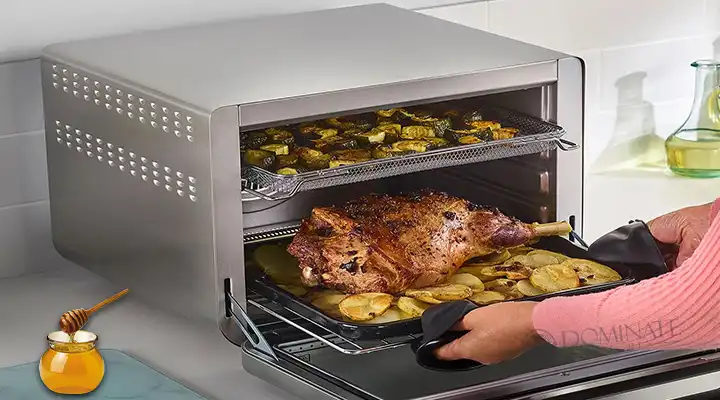Does Honey Burn In The oven | Does It Catch Fire?
There are plenty of people who have accidentally left a half-full jar of honey in the oven, only to find it blackened and sticky later. But why does this happen? Is it because honey is flammable? Or because it’s somehow combustible? If you don’t have a clear sense of whether honey burns in the oven or not, you’ll not be able to identify the exact reason for this happening.
Actually, this is a question that many people have asked, and there is a lot of misinformation about it to confuse you. In this article, we’ve provided all the necessary information to clear up your confusion regarding this matter.

Does Honey Burn In An Oven?
The answer is YES. If you’re planning on using honey in your next baking project, beware: honey can burn in the oven if not observed. That’s right, this sticky-sweet substance can go from harmless to harmful in a matter of minutes if it’s left unattended. So what exactly happens when honey burns? Well, when heated over a prolonged period, the sugars in honey caramelize and burn, giving off an acrid smell. Not only is this smell unpleasant, but it can also be dangerous; inhaling burning sugar fumes can irritate your lungs and throat.
Honey is a sugar, and like all sugars, it will caramelize and eventually burn if heated to a high enough temperature. The specific temperature at which this happens varies depending on the type of honey but is generally around 300 degrees Fahrenheit.
At lower temperatures, honey will simply become thicker and more viscous as the water content evaporates. This makes it ideal for use in baking, where a thickener is often desired. However, once the temperature gets too high, the honey will start to turn brown and form unpleasant burnt flavors.
Heating honey can sometimes form a hard crust on the outside while remaining liquid on the inside. But what is the explanation here? When sugar is heated, it undergoes a process called caramelization. This is when the sugar molecules start to break down and re-form into new compounds. One of these new compounds is called glucose, which has a lower melting point than sugar.
Undoubtedly, honey is a natural product with a variety of uses. One common use for honey is as a sweetener in baking recipes. However, this sweetener can actually be burned if it is heated too quickly or at too high of a temperature. To prevent burning, it is vital to heat honey slowly over low heat or warm it in a water bath. If you are using honey in the oven, make sure to set the temperature no higher than 350 degrees Fahrenheit and keep an eye on the food so that it does not overcook.
Can Honey Replace Sugar In Baking In The Oven?
We think honey can replace sugar to some extent. However, honey is a liquid, and so the honey will have to be heated up in order to make it into a syrup. The other problem is that honey burns very easily, so you’ll have to watch it carefully in the oven.
Nonetheless, honey is an excellent alternative to sugar for baking if you can maintain the cooking process safely. It has a low glycemic index, meaning that it doesn’t cause blood sugar levels to spike, and it also contains antibacterial properties to help prevent food poisoning.
If possible, we suggest avoiding honey instead of sugar. Because, sugar will caramelize in the oven and give your food a nice golden color, which looks much more appealing than honey. However, you can use honey as a sweetener in cakes and breads where you won’t be cooking them in the oven.
We recommend honey only to replace sugar in baking in the oven when you’re looking for a natural alternative to sugar. You just have to make some adjustments to your recipe and bake at a lower temperature. The key is to use less honey than you would sugar because it’s not as sweet.
How To Use Honey As Coating In The Oven?
Place honey in a bowl and microwave for about 1 minute. The honey should be warm and thin enough to coat foods after you dip it in the honey. Now place the foods in the oven and bake at 400 degrees Fahrenheit for 15 minutes. In that case, you don’t need to buy new pots. If you’re making a glaze for something like a ham, you should use honey as the coating. When you’re making a glaze for something like salmon or halibut, you need to use sugar, which will caramelize more quickly.
In the past, we’ve also used honey to coat meat and fish before roasting. Now we use it to coat almost every food if it suits our tastes. In any case, the honey makes a sticky, caramelized crust that’s incredibly tasty and easy to prepare. Not to mention, we can use the honey coating to perform other tasks as well.
For example, to protect the baked food from drying out, you can make a paste with some honey and water and use a brush to spread it over the crust. As it bakes, the honey-water mixture will caramelize, forming a glaze that seals in moisture while adding flavor and crunch to your finished product.
Last Speech
In all likelihood, honey won’t burn at the normal oven temperature or if it’s baked for a shorter time. If you leave honey in the oven at a high temperature, it can caramelize after some time, forming a hard crust. According to the outcome and look, you can call it burning. So, technically, honey can burn in the oven and turns into a blackened substance that is not consumable.






